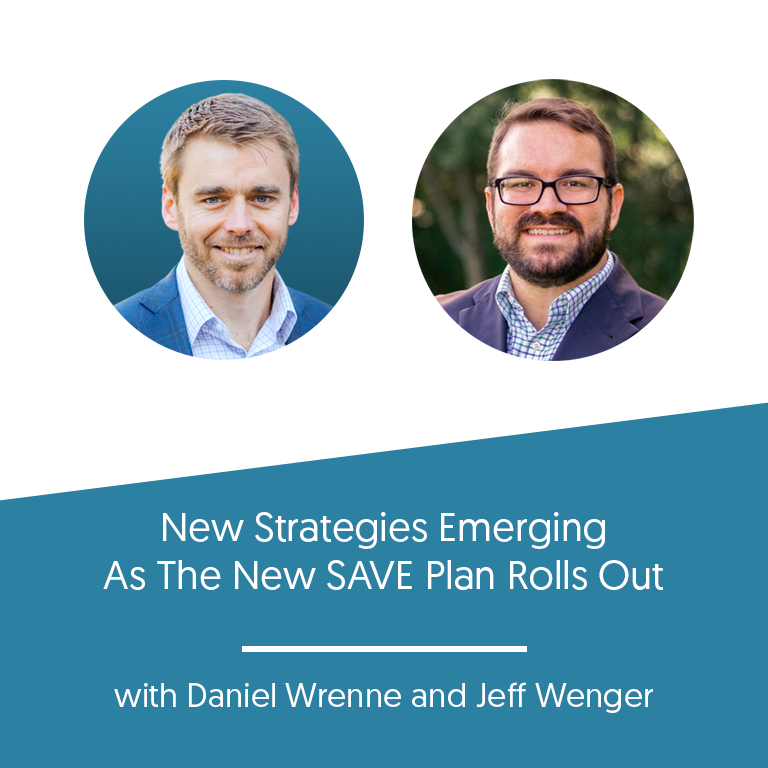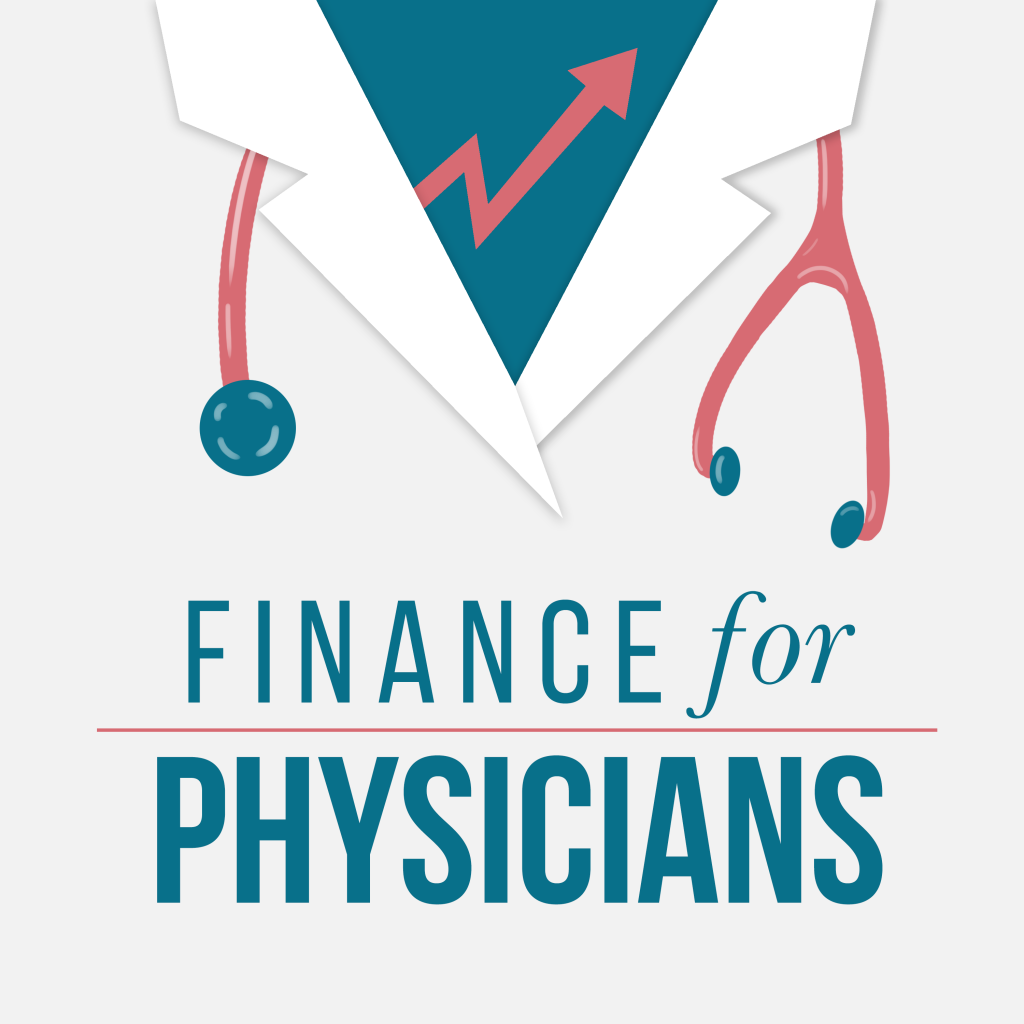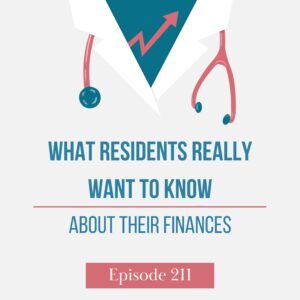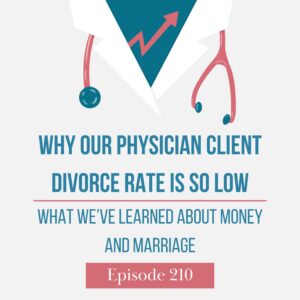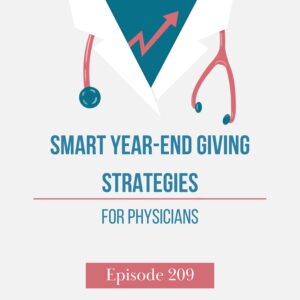In this episode, Daniel and Jeff dive into the intricacies of the new Student Loan Affordability and Value for Education (SAVE) Plan, shedding light on emerging strategies for student loan borrowers. The SAVE Plan is making waves in the world of student loan repayment, offering exciting opportunities for those seeking to manage their debt effectively.
The hosts explore the advantages and considerations of the SAVE Plan compared to other repayment options, such as PAYE and IBR, and discuss the crucial factor of filing taxes jointly or separately when optimizing student loan payments. They also touch upon the implications of the SAVE Plan for Public Service Loan Forgiveness (PSLF) and examine how it influences long-term loan forgiveness.
But that’s not all; Daniel and Jeff also tease an intriguing topic for their next episode: the possibility of buying back credit on PSLF. Tune in to stay informed about the latest developments in student loan management, discover new strategies, and navigate the ever-evolving landscape of student debt.
Whether you’re a recent graduate, a seasoned borrower, or just interested in the world of student loans, this episode provides valuable insights into the ever-changing student loan landscape.
P.S. We value your opinion! Share your thoughts and insights with us. Your feedback helps us improve and tailor our content to your needs. Click here to give us a piece of your mind.
Links:
To schedule a call with one of our awesome planners, book HERE.
Full Episode Transcript:
Daniel: Hello, Jeff.
Jeffrey Wenger: Hey, Daniel. Good to talk student loans with you
Daniel: again. Yeah, we, we meet again to talk student loans and I definitely enjoy the strategy more, understanding how things work is important. You got to understand that part, but it’s fun to talk strategy cause that’s where the rubber meets the road.
So we’re going to be talking strategy today with all these new student loan changes. It doesn’t get much better than that, Dan. Yep. So, there’s been a few changes, some big changes, and we talked about that a little bit last time. We’ll also link to some of the recent shows that we’ve covered. changes a little bit more in depth, but there’s some changes that are getting rolled out.
a lot of you listening probably have already like gotten put into like, for instance, this new repayment plan that’s out there, the safe plan, there’s. Some new rules around how you qualify for PSLF and there’s some new provisions that come with the new repayment plan. so we’re going to talk about some of these strategies that are going to come [00:01:00] into play, around these big changes.
So I think we also talked about the old way of doing things in our last conversation. maybe a good starting point is like. Are there situations where you should keep like the old plan in place? Are there people that are going to be like better off just continuing how they were doing it before or in other words not Making any changes or is that even possible?
Jeffrey Wenger: Right? So the old plan in place would be What they’ve been doing previously and and in general So it kind of the leaning there would be if you had, if you weren’t sure you would go on the PAY as you earn plan as an option or revised PAY as you earn, depending on where you were at and pay as you earn offered a payment cap and allowed you to file taxes separately while repay had an interest subsidy.
And so those are the two main ones. Right? And so first of all, do you need to make a change right now? I think that’s probably the first question to ask. Yeah. And that. Partly comes down to what’s your payment schedule to be now and [00:02:00] what plan are you on now as the payment pause ends, right payments are scheduled to kick back in at what they were pre pandemic or pre freeze.
Unless you certified income along the way. No one’s been required to certify income in the last three years. But if you have, for whatever reason, payments would resume based on that update instead of what they were pre pandemic. what that means is you may have a 0 payment that is scheduled to last for another year, or possibly more depending on what recertification dates you have on, on your file
Daniel: or a low payment or a low
Jeffrey Wenger: payment.
Yeah. I mean, I would certainly take a 25 payment or 150 payment over what, you know, what an attendings payment might be. If you’ve, you know, let’s say you graduated residency in 2019 and, you know, man, now you’ve gone through and four years into practice, five years into practice, that’s a, that’s a decent change in income.
Right. So, you know, first take a look at that. And so if the reason [00:03:00] being, if you are going to make a change on a student loan plan, so if you’re going to change to a different payment plan, or what happened, if you happen to need to consolidate your loans. That’s going to require a new income certification, which is going to reset your payment amount based on most recent income.
So does
Daniel: that make sense? So you want to be careful with anything that triggers your income to be verified again, particularly if you’re in a ultra low payment scenario. And especially if you’re going for because with PSLF, we want to make payments as low as possible for as long as possible. So the takeaway is you need to be aware of what your current payment is and get an idea of how long.
Would continue if you did nothing and there’s probably going to be a lot of people that should do nothing because that payment is so low because most people’s income goes up, but there’s going to be some of you that probably should do something before then like the longest you could do nothing would be your next income [00:04:00] certification date or the required date that you have to certify income.
So there’ll, there’ll be a date that will come around that will be like, you have to show your income. So that’s like you know, most delayed possible route of doing anything would be to do nothing until that date comes. What’s the date? That’s gonna be Jeff, the earliest. Yeah, so
Jeffrey Wenger: the earliest that anyone’s required to certify income at this point is March 1st of 2024.
So that’s March 1st of next year at the time we’re recording this. Anything that happened that is scheduled to occur before that gets a full year. Extension. And so let’s say you had your, anniversary, uh, anniversary loans. How delightful. but that was in February of 2024 was your scheduled time to recertify that gets pushed out all the way until 2025.
So sheesh, in that case, let’s say you are the luckiest of the lucky as far as timing goes on your student loan certification. [00:05:00] You know, you could have a, still a $0 payment or a low payment that lasts from now for another year and a half, and that’s why may wanna just double check that. Yeah, you can, lemme give you real quick, you can find that.
If you ever were to go to StudentAid. gov, there’s a file there called MyAidData. And if you were to just search for the term IDR Anniversary within that file, it will give you that date. that date, it’s any time earlier than March 1st, 2024, Push it out to whatever that same date is in the year following 2024.
Daniel: And that gives you, right. So a lot of people maybe just are going to delay that or, you know, let that thing play out as long as they possibly can. Now there’s a lot of exceptions to that. Like consolidation is the one, income’s gone down since. You’re that’s probably less likely, but, consolidation is probably the big one where there’s some of these new benefits out there, where it’s in your best interest to consolidate, even though [00:06:00] maybe the payment’s going to go up some, it starts to get complicated on where, how to figure that out.
But maybe we could talk through some of those examples where, maybe a consolidation makes sense, even though. It might affect your income payment. Yeah.
Jeffrey Wenger: So cases where a consolidation might make sense and. Right now we’re, we’ll talk about it time oriented, time urgent type stuff right now, because we are in a time period where if you consolidate by the end of this year, there are a whole lot of benefits to that compared to the way consolidations used to work and also the way that credit will be granted to them going forward.
And so, consolidating may make sense. If you have a few different options here, one would be maybe you’ve got really old loans and they’re on the old FFEL loan program. You, you might know that, one telltale sign would be if you had a private FFEL loan and the payments weren’t paused during the pandemic.
That’s one way, you know, you’ve got an old loan. what are we going to say, Daniel?
Daniel: How do you know if you have an FFEL loan? So a lot
Jeffrey Wenger: of the [00:07:00] times when you go to the servicer, it’s going to show up somewhere in the title of that loan, but the surest way to find out what kinds of loans you have are to go to that, that same file on studentaid.
gov and you can actually find out what the title, what the description of that loan is. And if it’s FFEL, it says that right in the description. So actually just search for FFEL. In that
Daniel: same document.
Jeffrey Wenger: Yes, and if it says that it’s not been paid in full or consolidated already, then you probably have an old FFEL loan.
Uh, the reason that’s a problem is that only direct loans qualify for, and so direct loans are a classification or, you know, specific type of loan that the federal program puts out there. but only the direct loans qualify for PSLF FFEL loans can qualify, but first they have to be consolidated into a direct loan.
And so if you’ve got those old loans to make them qualify, you’ll have to do a
Daniel: consolidation before the end of the year.[00:08:00]
Jeffrey Wenger: you could do that. Yeah. Before the end of the year would be best because we’re in a time period right now where. Any previous credit that you would have had on those loans gets consolidated as well.
Daniel: Right. so that basically the consolidation is a potential strategy to get otherwise not qualified payments to qualify. Right.
Jeffrey Wenger: So to get loans that wouldn’t have qualified to qualify one way. The other one is if you have loans and this may go hand in hand with having some FFEL, some old loans and some new loans is loans that have different payment histories on them.
So a common, I mean, not common, but some, a case I’ve seen multiple times in the last couple of weeks, even as someone that had some undergrad loans. They worked for a year or two full time and then they went to med school. So, you know, they weren’t working during that portion of the time, but they got new loans naturally.
That [00:09:00] seems to go hand in hand, med school loans, right? And then those med school loans start getting credit, you know, four years later when they hit residency. But if you combine those two together, you get those two years or a year of full time employment. A lot of times it seems like they’re university based employment then too, before you go, stereotype may be here, but that’s, that’s what we’re seeing with some of those.
And it’s not yet two more years from my undergrad loans credited towards my gigantic loans from med school. And that would be a reason to consolidate
Daniel: too. Yeah, that can be a home run now. And sometimes even if say you got that, say you’re not going to have to certify income until maybe February of 2025 at the longest.
So, and you’re, let’s say your payment’s really low. there’s this, there’s plenty of situations I can think of where even if you’re in that scenario where payments are low and they’re going to get. They’re going to continue to be low until, way down the road, like February of 25 that you still might want to consolidate [00:10:00] and voluntarily cause your payments to go quite a bit up because the benefit of that adding PSLF payments is substantial enough.
So that’s what you’re weighing. There is like a cost of increased payments over the next, however many months versus the benefit of. Sooner forgiveness or, yeah, basically sooner forgiveness. Yeah. So
Jeffrey Wenger: give that kind of a, an example, if you’ve got a 5, 000 FFE all alone, hanging out there and certifying income now is going to make your payment 2, 000 a month higher.
That’s not the case for a consolidation, right? Yeah. Right. But if you have a larger old balance that could benefit from forgiveness or it could bring two years worth of credit to a giant balance from med school, then that’s certainly worth looking into.
Daniel: Yeah. And then there’s, there’s a few other strategies I’ve heard you talk about that tie into that consolidation strategy, we hadn’t hit on yet today, but, It pulls [00:11:00] in all your loans, right? Like not only, so we’ve been talking about the borrower’s loans, but the borrower could also be the parent.
Jeffrey Wenger: Oh yeah.
Daniel: So that’s where it gets crazy in my head. I mean, it’s student loans have been crazy for a while, but this is just yet another new crazy strategy that’s come about.
Jeffrey Wenger: Yeah. And this is really. Probably a time limited option, but going along with that IDR one time account adjustment that if you consolidate loans by the end of the year, they all get the same credit and applied to it, no matter what the payment plans were.
What we’re seeing there is there’s the lesser known forgiveness option 25 years. So payments, doesn’t matter where you’re employed at that point. It’s just 20 or 25 years of payments. those loans get forgiven as well, but we have some that have been paying on loans since like 1999, their own loans.
And now they have kids that have just finished college. And so they have parent plus [00:12:00] loans. And if you consolidate those loans together. Your old loans with the parent plus loans, those can get the credit as well. And so limited use case, but holy moly, what a benefit for those that have not
Daniel: that limited.
That’s true. I mean, there’s got to be a lot people that have children that are especially get big student loans where we’re seeing it is where you had some old federal loans that were just like super low interest rate and maybe you had the money to pay it off, but you’re like, it’s 2 percent interest rate.
So people were just paying the minimum payment on their 2 percent interest rate student loans, even though they could have paid it off and they’ve kind of drug it out for a while. So they still have it, but now they even fast forward to have having kids. And then maybe they’re starting to go to college.
And, that’s a potential viable strategy. It’s a very, very good strategy. but you gotta run the numbers on all these. so those, those are potential, considerations like leading up to. I think that first recertification date time, like you want to kind of get, this is [00:13:00] like housekeeping to think about in the short term, what about like beyond that first certification date?
I think that’s kind of the time when you got to really think about like, what am I just going to go with this new safe plan or
Jeffrey Wenger: yeah, that is where it gets to be.
Daniel: If it wasn’t already ready, already fun, it’s, it gets fun then.
Jeffrey Wenger: And I, so you want to go with what applies to the vast majority of individuals at this point? We’ll start there. We’ll start there would be the majority for the majority, the save plan, the new plan that’s out there is likely to be the lowest payment option that leads to loan forgiveness.
Yep. Particularly as it relates to public service loan forgiveness, PSLF. the reason being that It gives you the lowest payment option because it calculates the payment differently than all the other plans. It still allows you to separate income by filing taxes separate. So you get [00:14:00] the benefit of either option.
You get the choice to file separate or joint on this plan and choose which one’s more beneficial. and then that interest subsidy is helpful as well. If you happened to leave the PSLF program at some point, just refinance. So where that tends to make sense, and I’m going to give a rule of thumb, if that’s all right, would be if your income is roughly half of your student loan balance or more, let me go back and try and phrase that.
Cause I think I’m getting it backwards now, but if your loan balance is twice as large as your income. You’re definitely going to be, you’re very likely to be better off with the save plan than anything that has a cap because you’re, it’s going to be hard to reach that cap. You’re never going to reach that cap at twice the income.
Or twice the, the debt is your income. but as you, if you’re a higher income and lower debt, so we get more like to that one to one ratio, the closer you get to that, the more due diligence you need to do. The reason being that the save plan does not have [00:15:00] a cap on how high payments can go. So even though it’s got a lower payment calculated, it’s still a percentage based payment.
And if that percentage is higher than, what you would pay on another plan, it’s going to keep going up. And Daniel, can you remind us what the payment cap is? I’m talking about this payment cap, but can you help
Daniel: us out? The payee payment cap, yeah. The paid payment cap it’s a set limit amount of what you possibly could pay per month based on the 10 years standard repayment plan So it’s the payment you would have had to make it paid off in 10 years so Say, for instance, if you’re going to say you owe a hundred thousand on student loans and you’re making a million in a non profit hospital, like you’re going to cap it out, like you’re way over the cap on payee, that’s an easy scenario where it’s like payee still has a huge benefit because on the other plans, there’s no cap.
So they base it off a million dollars of income,
but that’s. Not, I mean, in our experience, that’s not the [00:16:00] majority for sure.
Jeffrey Wenger: Right. And so just to, let’s give that, that example, there are a million dollars in income, a hundred thousand dollars in student loans, 10 years of payments. And let’s forget interest rates for a second, Daniel. So 10 years to pay off a hundred thousand dollars of loans would mean how much would you be paying every year on a hundred thousand student loans over 10 years?
Daniel: I think I can get this one. Yeah. Actually grab your advocates for me. Oh, advocates. can we do this one on that? It’s 10 times. 10 is a hundred, 10, 000 a year, right?
Jeffrey Wenger: 10, 000 a year. And then to contrast that with a payment based on a million dollars in income, that’s all it gets to be. 80, 8, 500 a month.
Roughly. You can basically say 10, 000 a month.
Daniel: So you just pay the thing off in a year and get no forgiveness.
Jeffrey Wenger: But, and so historically that 10 year payment amount, that cap. if you were to just make 10 years worth of payments, they’re paid off anyway. In 10 years, there’s always been some [00:17:00] advantage to the crowd that we work with.
As you’ve gone through likely lower income years with high debt, as you’re going through residency fellowship. And so you get, three, five, seven, you can get a lot of credit, depending on how much training you go through towards PSLF, where you’re not paying at the level that it would take to pay it off in 10 years.
So if you’d ever paid it, A lower than a 10 year payment, you’re getting a benefit out of PSLF.
Daniel: And then if you throw three year COVID forbearance on top of it all, add another three years.
Jeffrey Wenger: Right. But if you were in that scenario, going to pay it off anyway with a plan that had no cap, then you could have benefited on PSLF, but not on that plan.
If there’s a cap on the plan, it
Daniel: doesn’t help out. Yep. So you want to preserve that cap. if your income is, I mean, I think either your balance is low. That’s another scenario that can happen. I’ve seen that happen where maybe your income is not really, really high, but like the ratio of your income to your loan is pretty [00:18:00] high.
So, maybe you had 50, 000 of. Loans and you’re on an, and you have an average physician income, you probably are getting close to exceeding the cap, I would say, or maybe, I guess you probably would exceed the cap in the safe plan. So you probably ought to think about like preserving some sort of income cap if you can.
So
Jeffrey Wenger: that would be. The time where you want to see if you, if that payment cap is going to be beneficial. So high income compared to relative to the loan balance is where that, that comes into play. for the vast majority that I’ve, I’ve looked at and analyze though, that income disparity, especially we’re talking, I’m going to say, I’m going to call this normal student loans.
It kind of hurts to say normal. Uh, when we say 250, 000, right? That’s pretty average. But if you have normal med school loans in the 250, 000 range, the income it takes to make that cap favorable to you at this point tends to be relatively large. So [00:19:00] we’re, we’re talking, probably looking at. 600, $700,000 level before where, where that more than double happens.
So, yeah. Uh, and that’s, that’s certainly gonna depend on each set of loans and income. that’s a good
way to think about it.
Daniel: So now the safe plan though, so most people are probably gonna, be better off in the save plan. you know, the minority will be better off sticking with like payee or even I could see I B R.
Being beneficial, in some cases, cause it has a payment cap as well. That’s an old repayment plan. We haven’t even talked about, but there’s cases where those are like the exceptions where you would benefit from those payment caps, but most people are going to go with a safe plan or be better off in the safe plan.
And that’s the default. If you were in repay, you were automatically switched to save, right? Yes. Yeah. So repay revise. They didn’t ask you anything. They just went ahead and moved you. It’s
Jeffrey Wenger: yeah It’s just it’s morphing like a power ranger into a new plan.
Daniel: so yeah, how did they morph the contracts?
Jeffrey Wenger: That is a good topic for another podcast. Maybe [00:20:00] Of concerns going forward
Daniel: But yeah, that could be a problem for courts. If it were to get tested in court, maybe,
Jeffrey Wenger: I don’t know. Yeah. We won’t even get into that here. Talk about. what the implications are of this plan going forward on the payment and how it’s playing out, but yeah, could be a lot of fun.
Yeah. So well hats too. That’d be a good one. Yeah.
Daniel: yeah. So save plan. You can file separate. I think the biggest one that’s going to make things complex for people is the file separately thing. Now that’s in play for everybody with the safe plan. It’s
Jeffrey Wenger: in play for everybody with the save plan. And most of the other plans already had that feature.
So basically there, there were some old strategies where it made sense to like file separate, but be on a plan that took into account some other income, but. You can just strike that from the record because it doesn’t matter anymore. but yeah, so you can file separately and then it only takes into account your income on the save plan.
Whereas the old repay plan did not have that feature. It always took your income and your spouse’s income, lumped them together to make the [00:21:00] payment calculation,
Daniel: which… Yep. So there can be some pretty big advantages. Well, or it’s really good, I guess, at a starting point, it’s good to have that option.
I mean, you want to have that option in your back pocket to be able to explore that strategy. So there’s all kinds of strategies. And if you end up going down the path of like filing separately, there’s, there’s all, we’re talking strategy. So there’s all kinds of strategy that goes with this whole file separately thing, because.
If you, depending on which spouse and how it’s working, like there can be times where it’s like, okay, well, if. say Mary spouse and John spouse number two, say, Mary’s got the one that’s got the student loans and then her income is lower than, maybe we’re going to say file separately and isolate her income for student loan calculation purposes, and then maybe even take it further, like let’s.
Make sure she’s maxing out the retirement plans pre tax and then maybe even further and say [00:22:00] like you have an HSA plan that’s a pre tax saying, and John’s got it on his plan, but like, it needs to be on Mary’s plan because she gets the extra kicker with the, so those strategies have been around for a while, but like now they’re open to pretty much, it’s a much broader swath of the, um, population that’s going to, they’re beneficial, but they’re complicated.
Jeffrey Wenger: Yeah. So maybe the choice to be on the plan is not as difficult. No, the save plan makes a lot of sense, but the choice on how to file taxes has become, something that’s going to take a little bit more
Daniel: effort. Yeah, because you’re like, how do I file separately? How do I know, how do I calculate filing separately?
You go to your accountant and they’re like, you’re an idiot for filing separately. why would you ever file separately? So then it’s like, why would I consider filing separately? But the accountant doesn’t know what they’re talking about usually for a student loan. Planning purposes. That’s
Jeffrey Wenger: a good point.
Student loans are not a part of the tax code. So they’re, you know, they’re not part of Anything that the average tax preparer is gonna come across in and even it [00:23:00] doesn’t impact the tax return itself usually You know loan deduction interest deduction, but that’s about it for student loans on the taxes, right?
You go in the other direction. It makes a big difference Right. So how do you decide? I mean, you’ve done a lot of these in the past. And how did you counsel people whether to file separate or joint?
Daniel: It was really just a matter of running the numbers. Um, see, well, if we’re working with you, we can run the numbers on this student loans and that kind of thing.
if you’re, if you’re doing it yourself, you need to have a way to run the numbers on what your payment is going to be in different scenarios. So that’s what we can do is we can run the payment. That you would in the future have based on different scenarios. So in this example, the scenario we’re going to run the numbers on are the scenario where you’re filing jointly versus the scenario you’re going to file separately.
We can run the different payments on those two scenarios. And show you the difference between the two payments. So if it’s like 600 a month on the jointly scenario, and then 400 a month on the separately [00:24:00] scenario. So that means you’re saving 200 a month by filing separately in this example. So 2, 400 a year, by filing separately.
So that’s step one is we, you know, calculate the cost difference of the two. And then step two is like. You got to run the tax numbers. So that’s where the accountants come into play. Like a lot of times they don’t realize that in most cases, when they, when you file separately, it hurts you on taxes. Like, like 99%, maybe of the time it makes it worse to file separately.
So accountants are like, what are you talking about? I’m like, I know that doesn’t make sense. So that’s why you have to be like, well, I know it doesn’t make sense on my taxes. Or maybe you preemptively say that you’re like. This is not about necessarily saving taxes. It’s a student loan thing. It’s going to affect my student loan.
So I need to know what the cost is. So we would word it like, can we, we were trying to figure out the cost, the added cost of filing separately on my taxes so that I can weigh that against the [00:25:00] added benefit for PSLF purposes. Cause you’re, we’ve already calculated. You’re saving 2, 400 a year on payments.
And if you’re going for PSLF, that’s pure savings. Like that’s money in your pocket. so we need to calculate the tax costs of filing separately. So tax costs, usually filing separately costs more in taxes than filing jointly. So we get the accountant to run those numbers or you do it in TurboTax. It’s kind of difficult to do in TurboTax because you have to run two completely different tax, scenarios.
but you can do it. So you just got to run those numbers and compare the total tax due in one versus the other and say, that number is safe, you know, 400. In other words, the tax costs is 400 for filing separately. That’s a win because Your net benefit is 400 PSLF benefit versus 400 tax costs. I’ll take the 2, 000, which is the difference of the two.
And those numbers can be, that, this is, that’s a, just a random number scenario. I came up [00:26:00] with off the cuff, but like the numbers we’re seeing, sometimes it can be substantial benefits. Yeah,
Jeffrey Wenger: it’s, it’s not uncommon for me to see the payment difference being 20, 000 a year by filing separate. And so, of course, you know, so 20, 000 a year savings on student loans.
And let’s say I, Oh man, let’s say I have to pay 10, 000 more in taxes. Which would you choose? Well, I would choose more money.
Daniel: I would choose the 20, 000 PSLF benefit, but I could see where that would be a hard decision because like the 10, tax due is like now. They’re like, that’s true. You got to pay him right now.
So that’s, I have worked through that decision with a lot of people and it’s not so easy. Even if it’s like straightforward, it’s not so easy to say like, I got to write a check for 10, 000 now, for a probable future thing. And at some point, Now, if it’s 10 years from now, I’m going to be like, [00:27:00] yeah, I’ll probably do it.
Cause I have confidence in the PSLF program, but like, I’m a little uncomfortable about that because I know the future is uncertain. So, I like it more when it’s like a thousand dollar tax costs for 20, 000 PSLF savings.
Jeffrey Wenger: Yeah. Oh yeah. You’re not kidding. Okay.
Daniel: But the 10, 000, 20, 000, I would still do it.
And like, if you’re, five years away from forgiveness or less, like say you’re one year away from forgiveness, that’s, that’s a pretty easy decision because you know, you’re going to get it in a year, but like the 10 year away from forgiveness, it starts to get hard to. Write checks now versus getting benefits 10 years from now, but generally speaking Yeah, I mean you want to take the net of all things better off outcome That’s a very
Jeffrey Wenger: fair way of it framing that as well of how much it hurts to write a 10, 000 check now
Daniel: Yeah, right.
It’s not I’ve never had anybody like rave about that kind of thing Turns
Jeffrey Wenger: out I’m heartless
Daniel: Daniel Oh, Jeff. There we go.[00:28:00]
Jeffrey Wenger: Well, any other places? So I, I can think of one other area where this gets a little bit more complicated for your strategy. Yeah. New save plan, but anything else you wanted to touch on with, with the area we were
Daniel: at following separately and jointly?
it gets a little, are were you gonna talk about community property states? Oh, I
Jeffrey Wenger: wasn’t even going to go there, but yeah, that’s a good one. I
Daniel: mean, it gets, if you’re living in a state that has community property, let’s Google the community property. Do you know him off the top of your head? I’ll
Jeffrey Wenger: basically make an L down the West coast over to Texas.
And then, yeah, what is it, Wisconsin, I don’t know how Wisconsin got involved in the community.
Daniel: Yeah, that’s the weird one. Washington, Idaho, Nevada, California, Arizona, New Mexico, Texas. Louisiana. That’s
Jeffrey Wenger: right. All the way to Louisiana, the L.
Daniel: And what’s the other one? Wisconsin, right? Wisconsin is a weird one.
So if you’re in one of those states, it’s a little [00:29:00] different for how you verify, or for when you filed taxes separately, they split the number equally. Like they just cut the total household income in half. They make you do that in community property states. Whereas in all the other states, they, when you file separately, they allow you to split it based on what each spouse earned.
So why that’s important is because if you live in one of those community property states, it’s going to be a pretty dramatic, well, if you, both you and your spouse make exactly the same income, this is irrelevant. But like most of the time that’s not true. So if you’re in one of those community property states, And both spouses work and it’s not the exact same same income.
It’s going to be potentially a Big difference in how this thing shakes out versus in all the other states
Jeffrey Wenger: I’ll just put this plug out there if you are in a community property state and trying to go through this it It is well worth the effort to engage with somebody that has worked on these types of plans before.
yeah, yeah, [00:30:00] it provides a whole lot of options there
Daniel: if you’re in a community property state Yeah, there are there are plenty of people now nowadays Uh, we can tell you jeff is one that you can pay him to give you student loan advice There’s other student loan planners that will give you specific advice on this thing like We’re talking like several hundred dollars, like five hundred bucks or so on average, these people typically charge.
We’re getting into like the super complicated scenarios with the community property states and especially if both spouses have student loans. Like that’s to me the most complicated is both spouses have student loans, both spouses work in a community property state. It gets, it gets really complicated fast there.
So that’s a time when it’s, I mean, a lot of times people are paying for advice for even some of the more, basic type stuff, because it gets complicated pretty fast. But this is, we’re getting into some of the more, the most complicated stuff is when we start talking community property states. So you just have to have that in your back pocket of something to be aware of.
If you’re in one of those states, it’s kind of different [00:31:00] than normal rules
Jeffrey Wenger: for taxes. The good news is, is that if you are in that situation, you know, a situation, did you know a community property state is now a situation? It’s a situation. Thank you. But if you are in a community property state, you’re not going to be, you can only be better off, I would put it this way, by using the rules that are available to you in there, in a community property.
Daniel: Yeah. you just have to be aware of it,
Jeffrey Wenger: but yeah, it does create more exciting analysis and students.
Daniel: All right. That’s all I got. You would have, you had another one. There was
Jeffrey Wenger: one other area I thought I wanted to touch on here. And that was, we focused on PSLF and that’s like. Most of the individuals we talked to are focused on.
but this new payment plan also makes the long term forgiveness quite a bit more complicated. long term being that on an income driven repayment plan over 20 or 25 years Of your employment, you can have loan forgiveness if you have a balance [00:32:00] remaining at the end things to consider about That would be that balance at this point in time is that would be taxable Unless asterisk, unless that were to occur in the next couple of years, and then it’s not taxable.
But, maybe most of us that are talking about 20 years from now, a 20 year plan are beyond that. So at this point it would be taxable balance. but the same plan is going to offer for the most part, the lowest payments for that long term forgiveness. But you have to make 25 years of payments. Some of the other plans.
We’ll have a higher payment, but you only have to make 20 years worth of payments. And so that has made this a quite a bit more complicated in analyzing that This is a case where and say if you are in a situation where you have twice as much in student loans as you do in income i’m thinking the six hundred thousand dollar student loan person making 250 or 300 000 income It’s almost a no brainer to [00:33:00] Yeah.
but it’s still a decision on lower payment, 25 years, higher payment, 20 years,
Daniel: and it just makes it a little tricky too when your, your income is higher. So like, let’s say your income is 300 and your loan balance is 450. Like then we start to get into, it depends a lot on, and I, in all the scenarios, it depends a lot on what we’re assuming your income is going to be for the next, you know, 25 years.
That’s a really long time. or maybe you’ve already had 10 years worth of payments. So then it’s like 15 years. That’s a big, big difference. but I think like a general, well, yeah, general statement is like that this new safe plan. Makes that 25 year forgiveness plan for a lot of people more appealing.
Jeffrey Wenger: Yeah, so it’s making it so that in general, if those circumstances apply to you, paying the five extra years on the save plan is still less out of pocket that you have to pay than 20 years on one of the other plans, particularly if you’re early on in [00:34:00] that payment
Daniel: history, right? There’s all kinds of exceptions and stuff like that.
So
Jeffrey Wenger: if you are just getting out of out of residency, making that decision now, save is likely. A good option to start off
Daniel: with there anyway. Sweet. All right. Well, we got into a lot of the strategies there’s a lot more and there’s going to be a lot more, I think that will come out or we’ll come up with, as we get into the weeds of all this, also we didn’t hit on, uh, some of the.
New things new provisions. There’s some new strategies. we hit on some of them But there’s some others that we didn’t hit on along the lines of like qualifying for pslf and employment and Will link to the show jeff and I talked about that quite a bit on the last show that we got into on student loans where there’s these employment based provisions, especially for, California and Texas.
those are big time potential benefits, or if you’re right on the cusp of full time employment, to think about, but make sure to check that out. If you have, or [00:35:00] if you’re curious about that or in that potential scenario. So, Jeff, it was fun talking student loans. Wait, we have one more. We’re going to talk.
Student loans again in our next conversation, our next show is going to be, what is the other, what is the other new thing that we haven’t hit on yet? We’ll give you a little teaser.
Jeffrey Wenger: Oh, and this is one without structure, but announced so far. What if you made a mistake? Can you go back and fix it? Yeah, that’s crazy.
To buy back credit on
Daniel: PSLF. I can’t even believe that that’s happening just cause it’s just, I don’t know. Anyway, we’re going to hit on that a little bit next time. So we’ll look forward to talking about that soon. Can’t wait.



